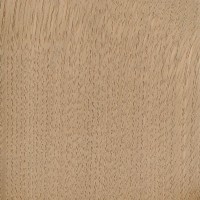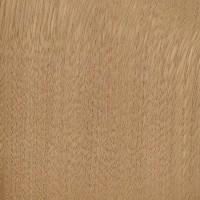 |
Common Name(s): Sweet Chestnut, Spanish Chestnut, European Chestnut Scientific Name: Castanea sativa Distribution: Europe and Asia Minor Tree Size: 100-120 ft (30-37 m) tall, 5-7 ft (1.5-2.0 m) trunk diameter Average Dried Weight: 37 lbs/ft3 (590 kg/m3) Specific Gravity (Basic, 12% MC): .50, .59 Janka Hardness: 680 lbf (3,010 N) Modulus of Rupture: 10,360 lbf/in2 (71.4 MPa) Elastic Modulus: 1,248,000 lbf/in2 (8.61 GPa) Crushing Strength: 6,360 lbf/in2 (43.8 MPa) Shrinkage: Radial: 4.2%, Tangential: 6.9%, Volumetric: 12.6%, T/R Ratio: 1.6 |
Color/Appearance: Heartwood is a light to medium brown, darkening to a reddish brown with age. Narrow sapwood is well-defined and is pale white to light brown.
Grain/Texture: Grain is straight to spiral or interlocked. With a coarse, uneven texture.
Endgrain: Ring-porous; 2-4 rows of large, exclusively solitary earlywood pores, numerous small latewood pores in dendritic arrangement; tyloses common; growth rings distinct; rays not visible without lens; apotracheal parenchyma diffuse-in-aggregates (short lines between rays).
Rot Resistance: Rated as durable to very durable, though susceptible to insect attack.
Workability: Overall easy to work with both hand and machine tools. Chestnut splits easily, so care must be taken in nailing and screwing the wood. Due to its coarse texture, turning is mediocre. Glues, stains, and finishes well.
Odor: No characteristic odor.
Allergies/Toxicity: Although severe reactions are quite uncommon, Sweet Chestnut has been reported as a sensitizer, causing skin irritation. See the articles Wood Allergies and Toxicity and Wood Dust Safety for more information.
Pricing/Availability: No data available.
Sustainability: This wood species is not listed in the CITES Appendices or on the IUCN Red List of Threatened Species.
Common Uses: Furniture, veneer, and carvings.
Comments: This tree is widely cultivated for the edible seeds which it produces.
None available.
Scans/Pictures: A special thanks to Steve Earis for providing the veneer sample of this wood species.
 |
 |





Just salvaged some chestnut barrels that have been exposed to the elements for 15 years. They were fine! The small nails used had rotted away entirely, but the wood was as solid as the day it was milled (probably 50 or more years ago, knowing the history of the building I got them from. Thought it was white oak initially, but the absence of the strong oak smell alerted me. The wood chosen for the barrels is slow-growth and very, very dense!
I would double check the end grain first before deciding they are indeed chestnut. It would be highly unusual to find chestnut ever being described as “very, very dense.” Since it is a ring porous wood like oak and ash, actually slow growth chestnut would tend to be lighter than normal, not heavier. I have a piece of old-growth white oak, and the big (and lightweight) earlywood pores comprise almost the entire grain structure. You can see pictures of it lower down on this page: https://www.wood-database.com/white-oak/#identification Even though it’s white oak, the slow-growth piece in the link feels about as… Read more »
Thanks for your reply.
I was planing some more of it yesterday (by hand, so a slow process), and I’m pretty sure it’s a mix of white oak (the heavier, dense stuff) and something else (probably chestnut). The insides are wine-blackened and the outsides painted in a heavy old red paint, so it’s hard to see what’s going on without some elbow grease. I’ll take some pictures of the grain, if that wouldn’t be an imposition…
:)
If you ever get access to the end grain, that would be the best way to try and ID the wood.
It’s one of my favourite woods. Widely used in northern Spain for beams and weather-exposed elements like window covers, balcony railing, window headers and such.
It starts quite clear but over time it turns a light tan, making it the slightly humble little brother of white oak as the color ends up being quite similar, maybe a bit darker. The ring pattern is a bit different.
This is my living room low table, which I made out of 4 10×7″ (~25x18cm) pieces of solid spanish chestnut from, simply plained, weighting around 35kg each.
Hi there, I thought you might like some more pics of sweet chestnut including end grain. This is recycled wood, probably 50 years old and has been sanded to 240 grit then sealed and varnished, so golden tone slightly exaggerated. Note on how easily it splits is very true :-)
the wood is loaded with tannins, so it stains purple upon contact with iron and accelerates rust. Use stainless steel screws. Fresh sweet chestnut sawdust will wreck your bandsaw blade and rails if not cleaned immediately.
Freshly sawn wood is yellowish and smells of pickles. Boards dry very evenly and hardly warp.
Common uses: fence posts, shingles, outside construction works, …
I second that – watch your tools. Immediate rust, I found much more so than with green oak.
I have a beautiful piece a very dark chestnut notched in a V that is from the lower Front piece of a clock case from the early 1800s no wormy holes at that time it was given to me by my uncle and will be given to my son as he is a joiner .
My husband‘s grandfather tried for 50 years to plant the chest nuts seeds before the squirrels could get them but as each one reach six years old it would bear a few little seeds and quickly die off .
I don’t understand a lot of this kind of information on this site. Is Chestnut a hardwood?
Yes. “Hardwood” doesn’t mean “wood that is hard”. Any wood that isn’t pine/fir is hardwood
One of my favourite trees. Best non exotic wood for outdoors furniture, like railings, porches, stairs… Resists rotting and moisture for up to 50 years. Been traditionally used to make roof shingles in so wet weathered places like England. Check out this absolute wonder: https://www.youtube.com/watch?v=UZA1J8RHltY Also, in my country (Catalunya), chestnut straight stump twigs were used to make high quality “tutors”, (the poles used in irrigated food gardens to help tomatoes, beans… climb sunwards), which were meant to last generations. Lately, they have been beeing sadly substituted by cheap canes on a yearly basis. Chestnut populations are endangered by “Xancre”,… Read more »
Hi, Just bought sweet chestnut for the first time, the tone is very dark and beautiful, and there is a VERY strong sweet odor when planning or sawing.
I use sweet chestnut to make handles and rims for my Trugs and it bends exceptionally well. see https://www.sussextrugs.com